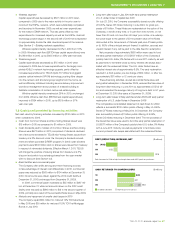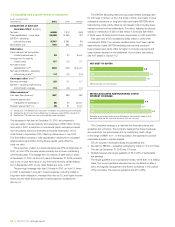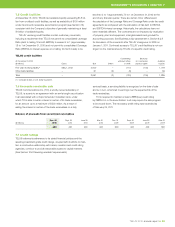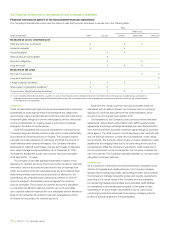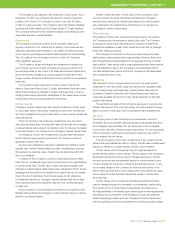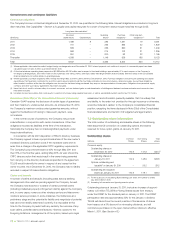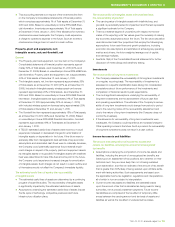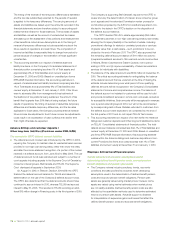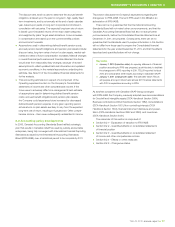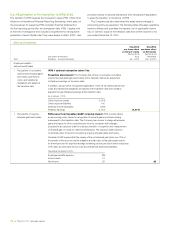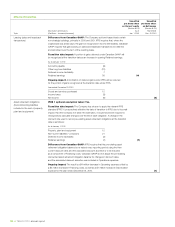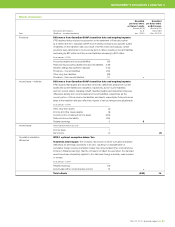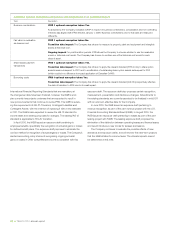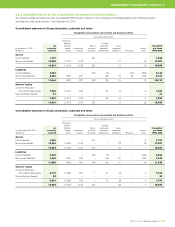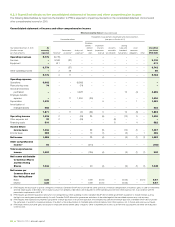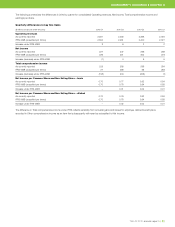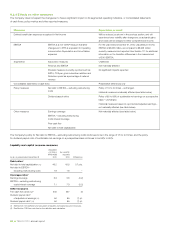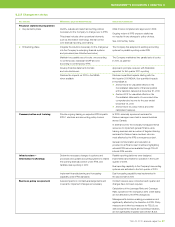Telus 2010 Annual Report Download - page 81
Download and view the complete annual report
Please find page 81 of the 2010 Telus annual report below. You can navigate through the pages in the report by either clicking on the pages listed below, or by using the keyword search tool below to find specific information within the annual report.
TELUS 2010 annual report . 77
This section discusses the Company’s expectations regarding the
changeover to IFRS-IASB. The term IFRS used in this MD&A is an
abbreviation of IFRS-IASB.
There can be no guarantee that the International Accounting
Standards Board will not make further pronouncements, and that the
Canadian Accounting Standards Board will also not adopt further
pronouncements, before the Consolidated financial statements as at
December 31, 2011, are prepared. Consequently, there can be no
guarantee that the standards used to prepare information in this Section
will not differ from those used to prepare the Consolidated financial
statements for the year ended December 31, 2011, and that the effects
described and quantified below will not change.
Key dates
.January 1, 2010 (transition date): An opening statement of financial
position according to IFRS was prepared, as at this date, to facilitate
the changeover to IFRS reporting in 2011. TELUS reported its fiscal
2010 and comparative 2009 results according to Canadian GAAP.
.January 1, 2011 (changeover date): The date after which TELUS
will prepare and report interim and annual 2011 financial statements
with 2010 comparatives according to IFRS.
As activities consistent with Canadian GAAP being converged
with IFRS-IASB, the Company previously adopted new recommendations
for Goodwill and intangible assets (CICA Handbook Section 3064),
Business combinations (CICA Handbook Section 1582), Consolidations
(CICA Handbook Section 1601), Non-controlling interests (CICA
Handbook Section 1602), financial instrument disclosure and presen-
tation (CICA Handbook Sections 3862 and 3863), and Inventories
(CICA Handbook Section 3031).
The remainder of this section is comprised of:
.Section 8.2.1 – Explanation of transition to IFRS-IASB
.Section 8.2.2 – Quantified effects on consolidated statements
of financial position
.Section 8.2.3 – Quantified effects on consolidated statement
of income and other comprehensive income
.Section 8.2.4 – Effects on other measures
.Section 8.2.5 – Changeover status.
MANAGEMENT’S DISCUSSION & ANALYSIS: 8
The discount rate, which is used to determine the accrued benefit
obligation, is based upon the yield on long-term, high-quality fixed
term investments, and is set annually at the end of each calendar
year, based upon yields on long-term corporate bond indices in
consultation with actuaries. The expected long-term rate of return
is based upon forecasted returns of the major asset categories
and weighted by plans’ target asset allocations. Future increases
in compensation are based upon the current benefits policies
and economic forecasts.
.Assumptions used in determining defined benefit pension costs,
accrued pension benefit obligations and pension plan assets include:
discount rates, long-term rates of return for plan assets, market esti-
mates and rates of future compensation increases. Material changes
in overall financial performance and financial statement line items
would arise from reasonably likely changes, because of revised
assumptions to reflect updated historical information and updated
economic conditions, in the material assumptions underlying this
estimate. See Note 13 of the Consolidated financial statements for
further analysis.
.This accounting estimate is in respect of a component of the
Operating expenses line item on the Company’s Consolidated
statements of income and other comprehensive income. If the
future were to adversely differ from management’s best estimate
of assumptions used in determining defined benefit pension
costs, accrued benefit obligations and pension plan assets,
the Company could experience future increased (or decreased)
defined benefit pension expense. In any given reporting period,
actual returns on plan assets are likely to vary from the expected
long-term rate of return, resulting in fluctuations in Other compre-
hensive income – Item never subsequently reclassified to income.
8.2 Accounting policy developments
In 2006, Canada’s Accounting Standards Board ratified a strategic
plan that results in Canadian GAAP, as used by publicly accountable
enterprises, being fully converged with International Financial Reporting
Standards as issued by the International Accounting Standards
Board (IFRS-IASB), over a transitional period to be complete by 2011.


